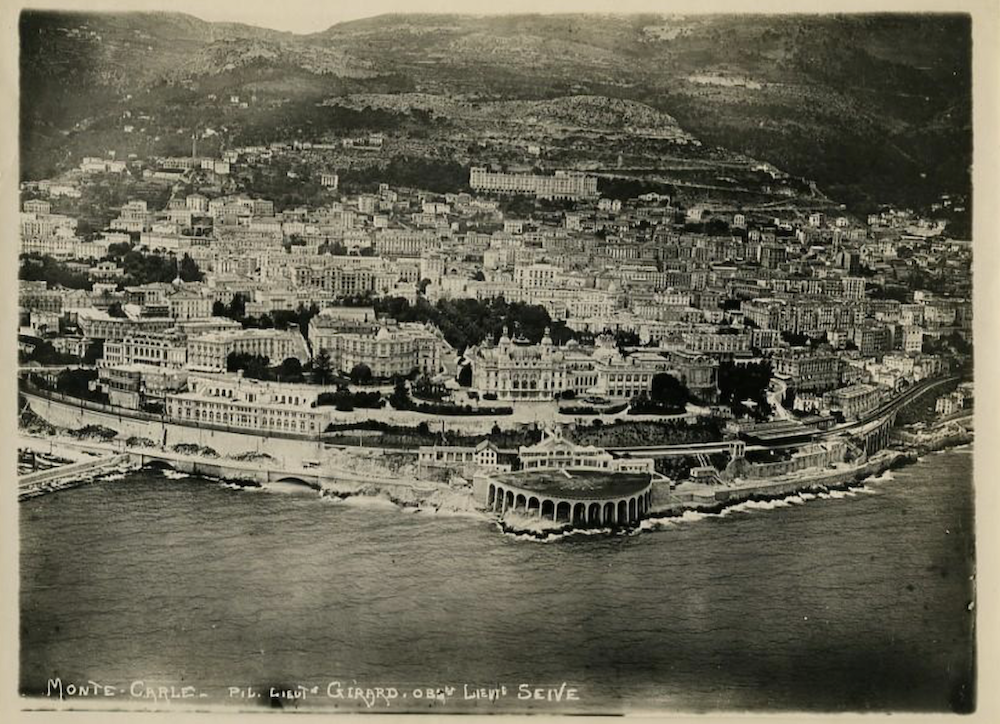Picture This: A Look at Casino de Monte-Carlo

DD sends me a seafront shot of what she thinks is a view of a church and a bathhouse (note both sections of the photo). I searched for a similar vintage photo, so that I could identify the seaside church with two spires and a Roman-style boathouse close to the shore. Come to find out, the church in the photo with the two spires is a kind of church, but not the religious kind (though the jury is out on that philosophical point); that building, so distinctive as seen from the ocean, is the Casino de Monte-Carlo.
The photograph is a long, narrow panoramic view, an aerial photo; aerial shots in 1920 were the purview of a division of the French Armed Forces, called the Girard Observers or the “Observateur Fleury Seive” as these silver gelatin photos captured famous locations in the 1920s. There are two other shots of a similar photo, which are offered today at AbeBooks by “Bits of Our Past” photography sellers in Poynton, U.K.
I was wrong about the two spires representing a holy place, but I figured the structure resembling a Roman Boathouse had to have something to do with water, and it in fact is part of the Oceanographic Museum.
The Casino de Monte-Carlo is a complex of gambling, entertainment, and arts offices, housing the Opera de Monte-Carlo and Les Ballets de Monte-Carlo. The whole complex is operated by the Société des Bains de Mer et du Cercle des Étrangers de Monaco, which translates to “the bathing and seaside society for strangers in Monaco.” Why strangers? The founder of the casino believed that the locals might be morally compromised if they worked in or gambled in the casino, so they were/are banned. It is a revenue-producing place taking foreigners’ money, and the income is received by the Royal Family of Monaco, who have since the mid-19th century owned the
founding company.
The genius behind this all was the Princess Consort of Monaco, Maria Caroline Gibert de Lametz (1793-1879), who became a Grimaldi after her marriage to Florestan I (1816-1856). When they met, both were having fun as actors in France; Florestan had no great designs to be a prince, especially since the Grimaldi family was poor by the standards of royalty in the day. Marie Caroline was destined to be a rich princess, turning the Grimaldi poverty into the Grimaldi fortune, and to do so, she amended the tax laws, and began the plan to imitate the greatest of all casinos, the Bad Homburg, in Monaco in the mid-19th century.
She begged the entrepreneur François Blanc, responsible for Casino Bad Homburg’s success, to work for the Grimaldi family, persuading Blanc to move to Monaco, a place with few roads. Francois Blanc set up the plans for a great casino in 1863, with his major investors being the Bishop of Monaco and Cardinal Pecci of Monaco, the future Pope Leo XIII. Marie Caroline named the enterprise after her heir, the future Prince Charles/Carlo.
Blanc had lent money to the French Third Republic so that France could complete the great Paris Opera House, and because of this he knew the greatest Beaux Arts architect of the day, Charles Garnier, who designed and built the Paris Opera House, now the Palais Garnier. His Monte-Carlo façade designs of 1878-79 are indeed the fabulous architecture we see today; the interior has been significantly altered.
The Casino de Monte-Carlo has been the center of the world of high-style gambling for years. After all, it is James Bond’s favorite casino, seen in Never Say Never Again, and of course, in GoldenEye. Ocean’s Twelve was set there in 2004. And much more happened over the years, such as experiments in mathematical probability “The Monte-Carlo Effect,” where various notorious gamblers tried to beat the odds in such a palatial setting.
The first gambler who tried to cheat the odds was celebrated in a popular eponymous song “The Man Who Broke the Bank at Monte-Carlo” (1892) by vaudevillian Charles Coburn, featuring an off-kilter roulette wheel. Another attempt at breaking the casino’s bank was celebrated in a book written by Ben Mezrich titled Bringing Down the House, and Busting Vegas, the true story of a group of math geeks attempting to break the bank by counting cards – the exploits of the MIT Blackjack Team in 2003. Such a famous place is featured in this 1920s aerial photo, which is worth $90.






